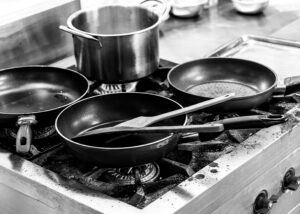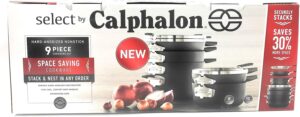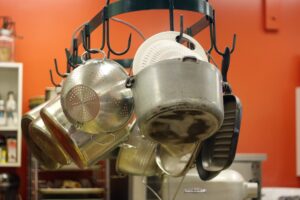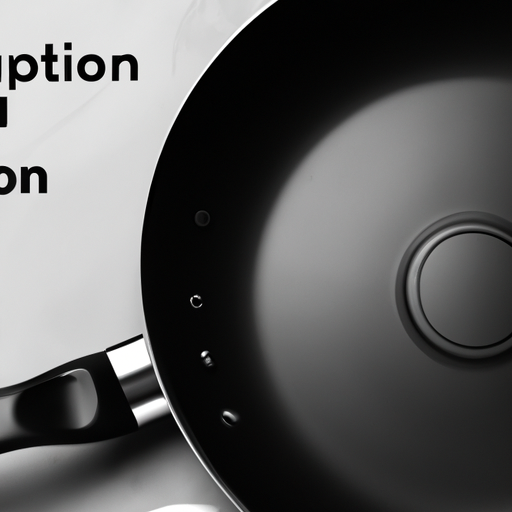Calphalon pans are a popular choice for many home cooks, known for their durability and non-stick cooking surfaces. But how often should you actually replace these pans? In this article, we will explore the answer to this commonly asked question and provide you with some valuable insight. Whether you’re a seasoned chef or just starting out in the kitchen, understanding when it’s time to upgrade your Calphalon pans is essential for maintaining optimal cooking performance. So, let’s delve into this topic and discover the signs that indicate it’s time for a replacement.

Factors to consider when replacing Calphalon Cookware pans
When it comes to replacing your Calphalon cookware pans, there are several important factors to consider. These factors will help you determine whether it’s time to invest in new cookware or if your current pans still have some life left in them.
Quality of the coating
One of the first factors to consider is the quality of the coating on your Calphalon cookware pans. Over time, the nonstick coating can wear down, making it less effective in preventing food from sticking. If you notice that your pans are not performing as well as they used to, it may be a sign that the coating is worn and it’s time to replace them.
Frequency of use
Another important consideration is how often you use your Calphalon cookware pans. If you are an avid cook and use your pans on a daily basis, they may wear out faster compared to someone who only cooks occasionally. The more frequently you use your pans, the more wear and tear they will experience, which can lead to a shorter lifespan.
Type of utensils used
The type of utensils you use with your Calphalon Cookware pans can also impact their lifespan. It’s important to use nylon or wooden utensils when cooking with nonstick pans, as metal utensils can scratch and damage the coating. If you regularly use metal utensils or have noticed scratches on the surface of your pans, it may be a sign that it’s time for a replacement.
Cleaning and care
How you clean and care for your Calphalon Cookware pans can greatly impact their lifespan. It’s important to follow the manufacturer’s instructions for cleaning and avoid using abrasive cleaners or scrubbing pads that can damage the coating. Additionally, if you consistently put your pans in the dishwasher instead of hand washing them, it can lead to quicker deterioration of the nonstick surface.
Appearance and performance
Lastly, consider the overall appearance and performance of your Calphalon Cookware pans. If you notice that the pans have become warped or distorted, it can affect their ability to heat evenly. Uneven heating can result in food cooking unevenly and can be frustrating to work with. Additionally, if you find that your pans are losing their nonstick properties or exhibiting signs of rust or corrosion, it may be a clear indication that it’s time to replace them.
Signs that it’s time to replace your Calphalon Cookware pans
Now that you are aware of the factors to consider when replacing your Calphalon pans, let’s delve into the specific signs that indicate it’s time for new cookware.
Scratches on the nonstick surface
One of the most common signs that it’s time to replace your Calphalon pans is the presence of scratches on the nonstick surface. While minor scratches may not immediately impact the performance of the pans, they can worsen over time and eventually lead to the nonstick coating peeling or flaking off.
Peeling or blistering of the coating
If you notice any peeling or blistering of the nonstick coating on your Calphalon cookware pans, it’s a clear sign that they need to be replaced. Peeling or blistering can occur due to excessive use, overheating, or the use of abrasive cleaning methods. When the nonstick coating starts to come off, it not only affects the effectiveness of the pans but also poses potential health risks.
Warped or distorted shape
Over time, Calphalon cookware pans can become warped or distorted, especially if they have been subjected to high heat or significant temperature changes. Warping can result in poor heat distribution, which leads to uneven cooking. If you find that your pans are no longer sitting flat on the stovetop or have a noticeable wobble, it’s a good indication that they are nearing the end of their lifespan.
Uneven heating
Another sign that it’s time to replace your Calphalon cookware pans is if they no longer heat evenly. If you notice hot spots or areas where the food is consistently sticking, it’s a clear indication that the pans are not distributing heat evenly. Uneven heating can make cooking a challenge and can result in dishes that are undercooked or burned in certain areas.
Pans losing their nonstick properties
The whole purpose of investing in Calphalon Cookware pans is to enjoy their nonstick properties. However, over time, the nonstick coating can wear down, making it less effective. If you find that your pans are no longer providing the effortless food release they once did, it may be time to replace them. Cooking with pans that have lost their nonstick properties can make cleaning more difficult and can result in food sticking and burning.
Rust or corrosion
Lastly, if you notice any signs of rust or corrosion on your Calphalon cookware pans, it’s definitely time for a replacement. Rust and corrosion can occur if the pans have been improperly stored or if they have been exposed to moisture for extended periods of time. Cooking with rusted or corroded pans is not only unappetizing but can also be harmful to your health.
Recommended lifespan for Calphalon Cookware pans
Now that you know the signs to look out for, you may be wondering how long you can expect your Calphalon cookware pans to last. The lifespan of Calphalon cookware pans can vary depending on the type of pan and how well they are cared for. Here are some general guidelines for the different types of Calphalon cookware:
Nonstick pans
Nonstick pans typically have a shorter lifespan compared to stainless steel or hard-anodized aluminum pans. With proper care, you can expect nonstick Calphalon cookware pans to last anywhere from one to five years. However, if you regularly use metal utensils or use high heat settings, the lifespan may be shorter.
Stainless steel pans
Stainless steel pans are known for their durability and can last for many years with proper care. With regular use and proper care, stainless steel Calphalon pans can last anywhere from 10 to 20 years or more. However, it’s important to note that the nonstick properties of stainless steel pans may diminish over time.
Hard-anodized aluminum pans
Hard-anodized aluminum pans are designed to be durable and long-lasting. With proper care, you can expect hard-anodized aluminum Calphalon cookware pans to last anywhere from 10 to 15 years. These pans are known for their excellent heat distribution and resistance to warping, making them a popular choice among home cooks and professional chefs alike.
It’s important to remember that these are general guidelines and the lifespan of your Calphalon cookware pans may vary depending on factors such as frequency of use, cooking habits, and how well they are maintained.
Tips to extend the lifespan of your Calphalon Cookware pans
If you want to get the most out of your Calphalon cookware pans and extend their lifespan, there are several tips you can follow. By implementing these practices, you can keep your pans in great condition for years to come.
Use nylon or wooden utensils
As mentioned earlier, using nylon or wooden utensils with your Calphalon cookware pans can help prevent scratches and damage to the nonstick coating. Avoid using metal utensils, as they can scrape and wear down the coating over time. By choosing the right utensils, you can maintain the integrity of the nonstick surface and prolong the lifespan of your pans.
Avoid high heat settings
Exposure to high heat can adversely affect the nonstick coating on your Calphalon cookware pans. To extend their lifespan, it’s best to avoid using excessively high heat settings. Calphalon cookware pans are designed to distribute heat efficiently, so you can achieve great results using medium to medium-high heat. By avoiding high heat, you can prevent the nonstick coating from deteriorating prematurely.
Prevent overheating
In addition to avoiding high heat settings, it’s also important to prevent overheating your Calphaloncookware pans. Overheating can lead to warping, loss of nonstick properties, and even damage to the pan itself. To prevent overheating, it’s recommended to preheat your pans on medium heat and adjust as needed during cooking. Monitoring the heat and using moderate settings will help preserve the longevity of your pans.
Hand wash instead of using a dishwasher
While it may be tempting to throw your Calphalon cookware pans in the dishwasher for convenience, hand washing is recommended to extend their lifespan. Dishwashers can subject the pans to harsh detergents and high temperatures, which can deteriorate the nonstick coating over time. Instead, gently hand wash your pans using warm water and mild dish soap. This will help preserve the quality of the nonstick surface and ensure your pans last as long as possible.
Store pans properly
Properly storing your Calphalon cookware pans is another key factor in extending their lifespan. To prevent scratches and damage, it’s important to stack your pans carefully, placing a protective layer between each pan. You can use pan protectors or simply stack them with a soft cloth or paper towel between each pan. Additionally, avoid hanging pans by their handles, as this can put unnecessary stress on the handles and potentially lead to damage.
By following these tips, you can ensure that your Calphalon cookware pans stay in excellent condition for years of enjoyable cooking.

Benefits of regularly replacing your Calphalon Cookware pans
While it’s important to know when to replace your Calphalon cookware pans, you may be wondering why it’s necessary to do so. Regularly replacing your pans offers several benefits that enhance your cooking experience and ensure optimal performance.
Maintaining optimal performance
Over time, the nonstick coating on Calphalon pans can wear down, resulting in diminished performance. By regularly replacing your pans, you can enjoy the full benefits of a nonstick surface, which includes easy food release and effortless cleaning. New pans allow you to cook with confidence, knowing that your dishes will turn out as desired.
Avoiding potential health risks
As the nonstick coating on Calphalon cookware pans deteriorates, there is a risk of it flaking off and mixing with your food. Ingesting flakes of nonstick coating can potentially be harmful to your health. By replacing your pans when needed, you can eliminate this risk and ensure that your cookware is safe for use.
Enhancing the cooking experience
Cooking with worn-out or damaged pans can be frustrating and can impede your ability to create delicious meals. By regularly replacing your Calphalon cookware pans, you can enhance your cooking experience by using cookware that is in optimal condition. New pans heat evenly, provide a nonstick surface for easy food release, and allow you to take full control of your culinary creations.
By recognizing the benefits of regularly replacing your Calphalon cookware pans, you can make informed decisions about when to invest in new cookware.
When should you replace Calphalon Cookware pans under warranty?
If you discover issues with your Calphalon pans and they are still within the warranty period, you may be eligible for a replacement. Here is what you need to know about the Calphalon warranty and when it’s appropriate to seek a replacement.
Understanding the Calphalon warranty
Calphalon Cookware offers a limited lifetime warranty on many of its cookware products, including its nonstick and stainless steel pans. The warranty guarantees that the cookware will be free from defects in materials and craftsmanship under normal household use. It’s important to read and understand the specific terms and conditions of the warranty to determine if your pans qualify for a replacement.
Determining eligibility for replacement
To determine if your Calphalon cookware pans are eligible for a replacement under the warranty, you should carefully assess the issues you are experiencing. If the problems you are encountering align with the warranty coverage, such as peeling or blistering of the nonstick coating, you may be eligible for a replacement. It’s important to provide all necessary documentation, such as proof of purchase and details of the issue when contacting Calphalon’s Cookware customer service.
How to contact Calphalon Cookware customer service
To initiate a warranty claim or seek assistance, you can contact Calphalon’s customer service. They will guide you through the process and help determine if your pans are eligible for a replacement. You can usually find contact information on Calphalon’s official website, where you can reach out via phone or email. It’s advisable to have your proof of purchase and relevant details ready when contacting customer service for a smoother and more efficient process.
By following the guidelines provided by the Calphalon warranty and communicating effectively with customer service, you can ensure that your warranty claims are handled appropriately.

How to recycle or dispose of old Calphalon cookware pans
When it’s time to bid farewell to your old Calphalon cookware pans, it’s essential to dispose of them responsibly. Here are some guidelines on how to recycle or dispose of your old cookware.
Check local recycling regulations
Before disposing of your old Calphalon cookware pans, it’s crucial to check your local recycling regulations. Different areas may have specific guidelines on how to recycle metal cookware. In many cases, metal pots and pans can be recycled with other metal items. Contact your local recycling facility or visit their website to determine the specific requirements in your area.
Donate or give away pans in good condition
If your Calphalon cookware pans are still in good condition and simply no longer meet your needs, consider donating or giving them away to someone who could benefit from them. Local charities, community organizations, or individuals in need may greatly appreciate the donation of your cookware. Ensure that the pans are thoroughly cleaned and free from any damage before passing them on to a new home.
Proper disposal methods for damaged pans
If your Calphalon pans are damaged beyond repair or no longer safe to use, it may be necessary to dispose of them. Depending on your location, they may need to be disposed of as regular waste. To do so, wrap the pans securely in a bag or cover them in a way that minimizes the risk of injury during disposal. Place them in the appropriate trash receptacle or follow the guidelines provided by your local waste management authority.
By adhering to local recycling regulations, donating pans in good condition, and disposing of damaged pans properly, you can ensure that your old Calphalon cookware pans are handled in an environmentally friendly manner.
Alternatives to Calphalon cookware
If you find yourself in need of new cookware and are considering alternatives to Calphalon ccokware, there are several high-quality options available. Here are some alternative cookware brands and materials to consider:
Other high-quality nonstick cookware brands
If you enjoy the benefits of nonstick cookware, there are several reputable brands to explore. T-fal, All-Clad, and GreenPan are just a few examples of manufacturers known for their high-quality nonstick cookware. These brands offer a range of options with different features and price points to suit various cooking needs.
Stainless steel cookware options
Stainless steel cookware is renowned for its durability and versatility. Brands such as All-Clad, Cuisinart, and Viking provide a wide selection of stainless steel cookware sets and individual pieces. Stainless steel pans are known for their excellent heat distribution and retention, making them a favorite among professional chefs and home cooks alike. While they may not offer the nonstick properties of Calphalon, stainless steel pans are highly resilient and can last for many years with proper care.
Copper or cast iron cookware
For those seeking traditional and timeless cookware options, copper and cast iron are excellent choices. Copper cookware, such as those offered by Mauviel and Falk, provides superior heat conductivity and control, allowing for precise cooking. Cast iron, on the other hand, is beloved for its exceptional heat retention and unmatched durability. Brands such as Lodge and Le Creuset offer a wide range of cast iron cookware options, including skillet pans, Dutch ovens, and grill pans.
When choosing an alternative to Calphalon, consider your cooking preferences, budget, and desired features to find cookware that suits your needs.
Expert tips on maintaining and caring for Calphalon Cookware pans
To ensure the longevity of your Calphalon cookware pans and keep them in optimal condition, here are some expert tips on maintaining and caring for them:
Preventing scratches and damage
To prevent scratches on the nonstick coating, always use nylon or wooden utensils when cooking with your Calphalon cookware pans. Metal utensils can scrape the coating and shorten the lifespan of the pans. It’s also important to stack your pans carefully, placing a protective layer between each pan to prevent them from rubbing against each other.
Seasoning the nonstick surface
Occasionally seasoning the nonstick surface of your Calphalon cookware pans can help maintain their performance. To do this, heat a small amount of oil in the pan over medium heat until it shimmers, then carefully wipe away any excess oil with a paper towel. This simple process helps to condition and reinforce the nonstick coating.
Proper cleaning techniques
To clean your Calphalon cookware pans, it’s best to hand wash them using warm water and mild dish soap. Avoid using abrasive cleaners or scrubbing pads, as they can damage the nonstick coating. Instead, use a soft sponge or cloth to gently clean the pans. If there are stubborn food residues, you can soak the pans in warm, soapy water before cleaning.
Storing pans correctly
Proper storage is key to preventing damage to your Calphalon cookware pans. When stacking your pans, place a protective layer, such as a pan protector, between each pan to avoid scratches. If you have limited cabinet space, consider hanging your pans on a pot rack or using hooks to keep them organized and easily accessible.
By following these expert tips, you can ensure that your Calphalon cookware pans remain in great condition and provide you with many years of enjoyable cooking.
Final thoughts on replacing Calphalon Cookware pans
Assessing the condition of your Calphalon cookware pans and knowing when it’s time to replace them is crucial for maintaining a well-equipped kitchen. By considering factors such as the quality of the coating, frequency of use, type of utensils used, cleaning and care, and appearance and performance, you can make informed decisions about the lifespan of your pans.
Recognizing the signs that indicate it’s time for new cookware, including scratches on the nonstick surface, peeling or blistering of the coating, warped or distorted shape, uneven heating, pans losing their nonstick properties, and rust or corrosion, helps ensure that you are cooking with safe and efficient equipment.
Knowing the recommended lifespan for different types of Calphalon cookware pans, such as nonstick, stainless steel, and hard-anodized aluminum, allows you to plan and budget for replacements accordingly.
Implementing tips to extend the lifespan of your Calphalon cookware pans, such as using nylon or wooden utensils, avoiding high heat settings, preventing overheating, hand washing instead of using a dishwasher, and proper storage, can help prolong their longevity.
Regularly replacing your Calphalon cookware pans offers benefits such as maintaining optimal performance, avoiding potential health risks, and enhancing the overall cooking experience.
If your Calphalon cookware pans are under warranty and need replacement, understanding the warranty terms and contacting Calphalon customer service is essential.
When it’s time to say goodbye to your old Calphalon cookware pans, remember to check local recycling regulations, donate or give away pans in good condition, and dispose of damaged pans properly.
For those considering alternatives to Calphalon cookware, exploring other high-quality nonstick cookware brands, stainless steel options, and traditional materials like copper or cast iron can provide a range of options to suit individual preferences.
By following expert tips on maintaining and caring for Calphalon cookware pans, including preventing scratches, seasoning the nonstick surface, proper cleaning techniques, and storing them correctly, you can keep your pans in excellent condition for years to come.
Ultimately, assessing the condition of your Calphalon cookware pans, considering individual cooking habits, and consulting the manufacturer when in doubt will ensure that you make the right decisions regarding replacement. With proper care and timely replacements, you can continue to enjoy the benefits of Calphalon cookware in your kitchen.




